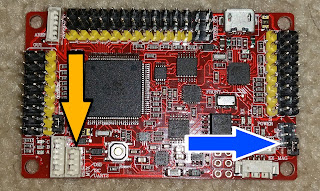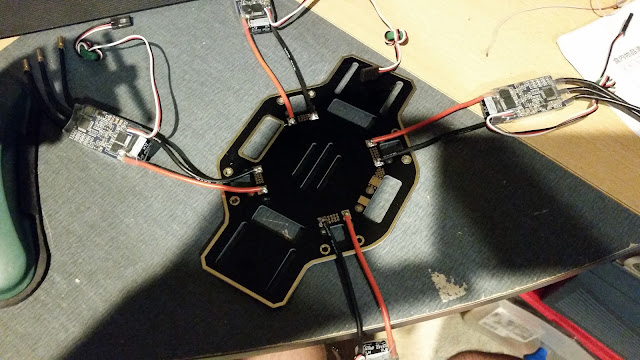Building a quad these days is easier than it would have been a few years ago. Almost all the components can easily be found on Amazon for a reasonable price. Sure, you can get a quad for a low price and in most cases the sum of components is greater than a RTF product, but where's the fun in that?
This blog will be about what I go through and how my build progresses
The core components for my build (excludes FC, remote, and battery)
Phase 1 - selecting all the components
Here's a general idea of the basics (I'll show what was picked for my build after)
- Frame
- Motor + Props
- ESC
- Flight Controller
- Battery
- RX (Reciever) and TX (Transmitter)
- Weight (not an item, but topic)
The Frame:
This is somewhat subjective and dependent on how the quad is being used. For racing, the design should be centered around a 250 and not a 450. For load/power go higher towards 450. For extreme go higher and with more arms. The size is limitless, however there's a fine balance between frame size, flight time and maneuverability.
The Motor:
Motors range from high-speed to low speed. Each has a purpose and needs a prop that matches the motor. For example, pick a fast motor but a large prop and the motor may not have enough power to support the prop. Similarly using a 920kv motor with a 5045 will likley not leave the ground since the motor can't spin fast enough. Do some research on which matches your motor/prop and what the intent is.
The general rule of thumb is, if you want power/lift get a combo that has a high thrust ratio. If you want flight time focus on G/W (efficiency) and keep in mind the weight. You could have the most efficient motor/prop but loading it to the max would kill battery life as well.
At minimum:
- Keep the thrust-to-weight no less than 1 (otherwise it will never take off)
- Keep the weight of the motor as small as possible (helps with thrust-to-weight + flight time)
- Match the motor to the frame size, i.e. a 450 frame is well matched with a sub 1000kv motor with 9" to 10" props.
The ESC:
This is the easy part, pick one that matches the motor. For example, if a motor can draw a max of 18A pick an ESC with capability of no less than 20A. There's a few pits though, if you get an ESC with rating of 30A for a 18A load, nothing bad about that but the added weight could offset the benefit of life span of the ESC. Remember, just because it says 30A doesn't mean it's going to dump 30A and burn the motor. It just means that it has the capability to provide 30A.
The other thing to think about is the firmware on the ESC. Yes, firmware! Believe it or not they are micro-controller driven which accepts a PWM input which drives a 3-phase motor. The FETS (what constitutes the Amp rating) does the heavy lifting by turning on/off at specific frequencies to make the motor spin. The firmware makes a big difference in that the rate at which it does the commands to the motor can make an impact on flight stability, reaction and noise. A slow responding ESC (cheap budget ones) will work but expect to hear loud motor noises. SimonK is the current standard for ESC firmware as it has a frequency of 400+KHz vs a potential fraction of that. You can flash most ESC with SimonK because most of them are Atmega ucontroller but it does require additional tools/time.
The Flight Controller:
Now why would we need one of these? Well there's a lot of math and feedback loop calculations going on to keep a quad flying correctly. Think about this: If you had to deal with 4 individual thrust generating devices to level a platform you'd likely need 2 people to manage just a stable hold. The FC takes the simple inputs of forward/back/left/right/up/down/rotate and calculates the power per motor accordingly.
Now, beyond the basics there are a multitude of FC out there but they all run on the same idea. After doing my own research it seems that ARM based FC are going to be the new norm due to the larger ROM capacity along with compute power. Arduino is still going to exist for quite some time and is still a viable solution (maybe preferred for those who know the IDE) but will not be able to take in some more advanced features.
Here's a small list of people/companies
- Arduino/Atmega
- Arducopter (ARM as well)
- MultiWii (can support down to 328p)
- ARM
- OpenPilot - basic flight controller with some upgrades possible
- Areoquad multiple sensors on board)
- Naze32 (maybe the same as Areoquad, same sensors)
- RaspberriPi
- Naza (DJI controller)
Some light reading:
PID Wiki
The Battery:
Battery, like a motor, is subjective. It has some dependency on what you want to do with the quad. The main thing to keep in mind is ballance power vs weight. At some point the weight exceeds the benefit of flight time if that's the angle. Or the weight exceeds the maneuverability capability and it becomes sluggish.
What will become evident is that quad that claim to have 20-25 minute battery life tend to be overstated. Some are true others reach that by special means (no auto-stabilization/gps/camera/load/etc). If the envionment is indoors the battery life is going to be much better than outdoors. Flying fast vs slow will also impact flight time. Extra equipment/load or electrical draw will impact flight times.
The RX/TX:
This is probably the easiest. Get something that matches the budget and anticipated range. Also, at minimum for a intermediate quad, like this build, get a 6ch remote.
What do channels mean? Each channel is a controllable function.
ch1: left/right
ch2: forward/bck
ch3: throttle
ch4: rudder
ch5: AUX1 (switch/multi-position switch/rotor)
ch6: AUX2 (switch/multi-position switch/rotor)
Now there are a multitude of remotes out there. Some will be hundreds and some will be $40's. Look through forums and read reviews. Pick one that will suit the needs of the craft which is typically range.
Weight:
You've heard me talk a lot about weight. This is a big component in making a quad work as it dictates many of the components and features that make up a quad. If the quad can properly manage Thrust-to-weight ratios then the rest, as they say, is history. What I mean by properly manage T/W is that not over-doing the thrust otherwise the flight time would be bad. Also not under-doing T/W which would impact load and also flight characteristics.
So what I purchased
Frame
Motor + Props
Generic 920KV motor
ESC
Flight Controller
Battery
RX (Reciever) and TX (Transmitter)
Weight (not an item, but topic)
Should be all around 1KG or slightly less. (measurement to come later)
Other items
solder + soldering station
shrink wrap
blade balance
RX to FC wires
motor connector
wire (just to connect the battery to power distribution board) Gauge 10/12 will work well, higher gauge (numerically) means less current capability so match this to the motor draws at peak power.
battery connector (match to your battery, the ones I got are T connectors. Others maybe different.
Some final thoughts
Before grabbing that soldering iron and going at it, spend 10 minutes just testing out everything. Get a 12V power supply of some type, wire it to one ESC and make sure that works and that it controls the motors properly.
Here's a step-by-step verification
- 8-12V PSU (a computer PSU is ideal) with at least 5A capability
- We don't need as much power as the motor demand is going to be. Reason is that with no loads (props) the power requirement from the motor is significantly less than when under load for the same speed. Most actually draw less than 1A but the overhead is always a good idea for supply.
- Pick one ESC, wire power to PSU
- Hook ESC (thin header cable) to RX ch 3 (throttle), Keep in mind the ground wire and orientation on the RX along with power and signal. We don't want to fry something here already!
- Power on PSU
- make sure RX gets power and binds to remote
- Power off PSU
- Hook a motor up to the ESC
- Power on PSU
- Give a little throttle, make sure motor works
- Full throttle (careful about motor shift) and make sure there are no noises that sounds like and old HDD or anything funny.
- Power off PSU
- Repeat 2-11 until you go through all motors and compare noises/speeds/etc to others.
- This identifies if any motor is going bad and needs to be replaced
- Make sure to Power off PSU
- Replace ESC with another, and continue steps 2-11 with a single motor to verify and each ESC works and gives that motor same sounds
- Power off everything
- Done
- Unless you're very paranoid, get the scope and look at the power signals coming out of each ESC to make sure it's stable during all power operations/loads. This could potentially solve issues later if the quad "drops out of the sky" when you do something mid-air as the ESC basically browned out the micro controller.
I had 1 bad bearing on a motor and replaced it (Thankfully Amazon is awesome about replacements). Doing the above steps not only saved me time but also issues as I would have soldered on the connectors at that point which may have complicated the return process/acceptance.
Next update will come once I get the new motors







